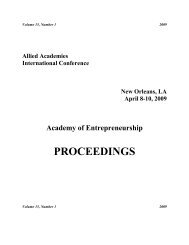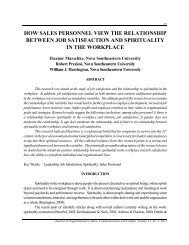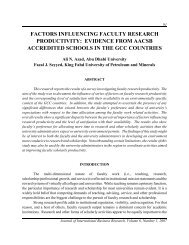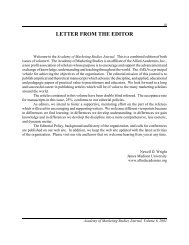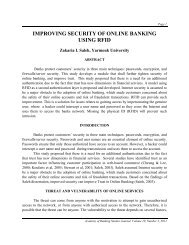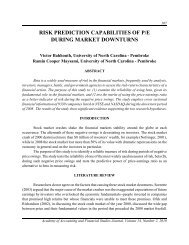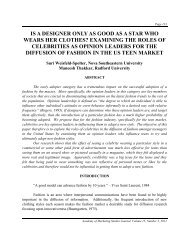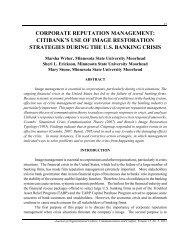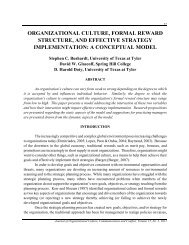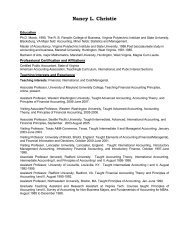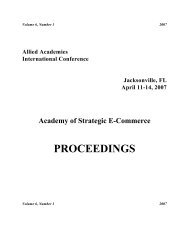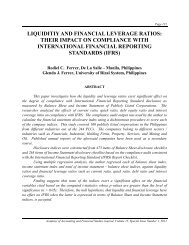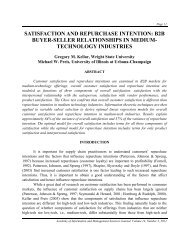AOCCC - Allied Academies
AOCCC - Allied Academies
AOCCC - Allied Academies
Create successful ePaper yourself
Turn your PDF publications into a flip-book with our unique Google optimized e-Paper software.
page 14<br />
<strong>Allied</strong> <strong>Academies</strong> International Conference<br />
ATTRIBUTION THEORY<br />
Originating from Heider’s (1958) description of the "naive psychologist", attribution<br />
theory attempts to find causal explanations for events and human behaviors. Several models<br />
have been developed from this idea, which attempt to explain the process by which these<br />
attributions are made in the case of self attribution (e.g. Weiner, 1974; Abramson, Seligman &<br />
Teasdale, 1978) and social attributions made regarding the behaviors and outcomes of others<br />
(e.g. Kelley, 1973, Thomson and Martinko, 2004).<br />
The attributional model of achievement motivation and emotion has evolved over the past<br />
20 years as an influential theory in social psychology and management (McAuley, Duncan, &<br />
Russell, 1992). Weiner (1974), in his development of the achievement motivation model of<br />
attributions, classified causal attributions across two dimensions; the locus of causality, and the<br />
stability of the cause. The first, locus of causality, originally proposed by Rotter (1966), is the<br />
degree to which the attributed cause is internal to the person, or part of the external environment.<br />
Internal attributions might include factors such as low intelligence, or lack of attention. External<br />
attributions could include weather conditions, or task difficulty. A second dimension, stability,<br />
refers to the degree to which the cause remains constant over time. The example of low<br />
intelligence would be stable, where the example of lack of attentiveness, would be unstable.<br />
Weiner (1979) and Zuckerman and Feldman (1984) added the dimension of controllability to the<br />
achievement motivation model. This dimension focused on whether the cause of an event or<br />
behavior is controllable or uncontrollable.<br />
McAuley, Duncan and Russell (1992) expanded the concept of controllability by<br />
proposing dual dimensions of personal and external control. For personal control, the attributor<br />
indicates that he or she either can or cannot personally control the outcome of the event. The<br />
external control dimension measures the degree to which the attributor sees the situation as being<br />
controllable by anyone else, such as a supervisor or co-worker. Vielva and Iraurgi, (2002)<br />
suggest that a response indicating external control is different from a response indicating<br />
uncontrollability. This paper proposes that the type of attribution made by an employee is likely<br />
to impact an employee’s tendency to engage in escalation of commitment.<br />
ESCALATION OF COMMITMENT<br />
Traditional models of economic rationality posit that resources should be allocated and<br />
decisions based on an assessment that the benefits outweigh future costs (Vroom, 1964), yet<br />
managers’ tendencies to throw “good money after bad” have been well documented and<br />
examined from multiple perspectives. There is a strong stream of research that examines<br />
misguided persistence from the commitment perspective, recognizing that both behavioral<br />
consistency expectations and self-justification processes play an important role when<br />
commitment escalates. According to Staw (1984), self-justification processes play an important<br />
role in commitment decisions and therefore can cause commitment to escalate. Self-justification<br />
theory postulates that managers will bias their future decisions in order to justify their past<br />
behavior. Further, research has shown that managers may selectively filter information from their<br />
Orlando, 2011<br />
Proceedings of the Academy of Organizational Culture, Communications and Conflict, V.16(1)



